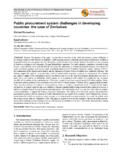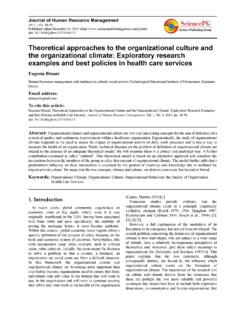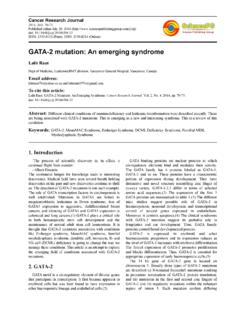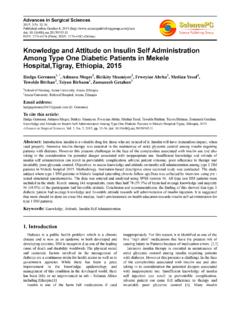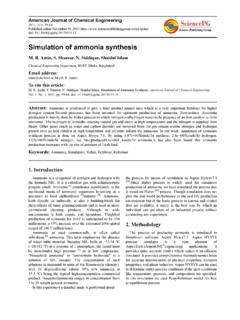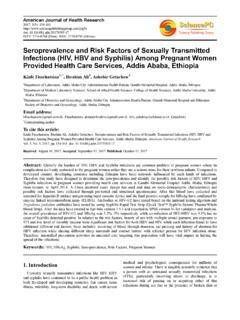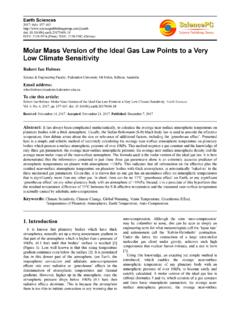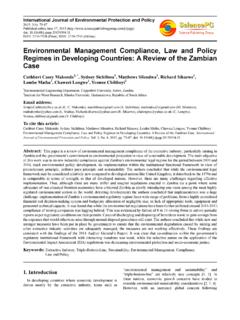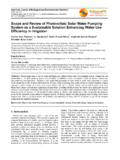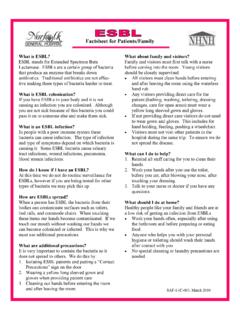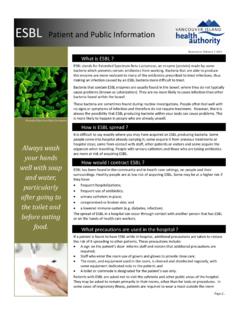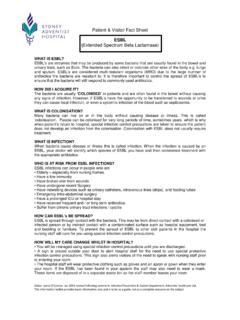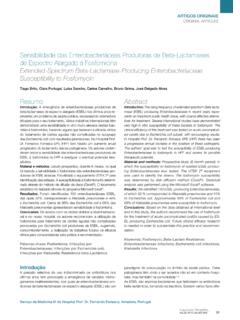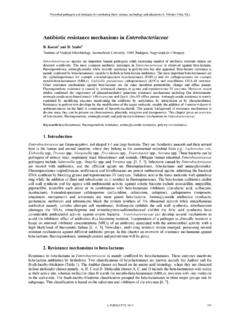Transcription of Multiple drug resistance and ESBL production in …
1 American Journal of BioScience 2014; 2(1): 5-12 Published online December 30, 2013 ( ) doi: Multiple drug resistance and esbl production in bacterial urine culture isolates Riffat Iqbal, Abdul Majid*, Iqbal Ahmad Alvi, Azam Hayat, Farah Andaleeb, Saira Gul, Sabeena Irfan, Mujaddad Ur Rahman Department of Microbiology, Hazara University, Mansehra Pakistan 21300 Email address: (R. Iqbal), (A. Majid), (I. A. Alvi), (A. Hayat), (F. Andaleeb), (S. Gul), (S. Irfan), (M. Ur Rahman) To cite this article: Riffat Iqbal, Abdul Majid, Iqbal Ahmad Alvi, Azam Hayat, Farah Andaleeb, Saira Gul, Sabeena Irfan, Mujaddad Ur Rahman. Multiple drug resistance and esbl production in Bacterial Urine Culture Isolates. American Journal of BioScience. Vol. 2, No. 1, 2014, pp. 5-12. doi: Abstract: Transmission of bacterial strains between patients is a serious problem in hospitals and with the increasing rate of antibiotic resistance the problem has farther escalated. Enterobacteriaceae produced ESBLs, especially E-coli, are increasingly important nosocomial pathogens.
2 These bacteria are often Multiple resistant and are responsible for many intestinal infections and urinary tract infections. Urine samples [4010] were collected cultured and the bacterial isolates were identified in this study, 1000 isolates showed significant bacterial growth. Among the sample 1000 showed bacterial growth in which strains was most common of the 1000 bacterial isolates from urine cultures, gram negative rods accounted for %, while gram positive cocci accounted for the test %. Total pathogen isolated and recovered is distributed as K. pneumoniae %, Enterobacter spp %, P. aeruginosa %, Proteus spp % Enterococci %, S. aurus % and E. faecalis %, A. calcoaceticus %, Enterobacter spp % E. agglumarance % serratia %. In case of g negative bacteria 58 [ %] were esbl producers and 379 [ %] were MDR. while in case of gram positive 2 [ %] were MRSA. resistance has arisen to all antibiotics introduced into general clinical practice and is likely to arise to any new antibiotics introduced in the future.
3 It is therefore imperative to consider what can be done to minimize the development and transfer of antibiotics resistance gene clusters. Methods can be developed to minimize antibiotic resistance . Keywords: MDR, esbl , Bacteria, UTI 1. Introduction Multiple drug resistance is a condition enabling a disease causing organism to resist distinct drugs or chemicals of a wide variety of structure and function targeted at eradicating the organism. Organisms that display multidrug resistance can be pathologic cells, including bacterial and neoplastic [tumor] cells [1]. Multidrug resistant [MDR] isolates are even more likely to be associated with complications in the therapeutic management of patients with infectious diseases [2]. Extended spectrum beta lactamases [ESBLs] are one of the most important causes of resistance to penicillin and cephalosporins in and Klebsiella spp. esbl producing bacteria are also frequently resistant to aminoglycosides, trimethoprim sulfamethoxazole and quinolones.
4 This situation restricts the treatment choices [3]. Antimicrobial resistance among the Enterobacteriaceae, a group of highly pathogenic Gram negative organisms, has increased dramatically in recent years against commonly used antimicrobials such as the tetracyclines, lactams, fluoroquinolones, aminoglycosides and co trimoxazole [4]. This is particularly true among pathogens such as Escherichia coli and Klebsiella pneumoniae that produce extended spectrum lactamases [ESBLs] [5], a class of enzymes that has been strongly correlated with multidrug resistance among the Enterobacteriaceae [6]. However, study during the last two decades found that bacterial resistance mediated by plasmids which carry resistance gene to a large number of antibiotics, which are rapidly transferred has worsened the scenario [7]. Urinary Tract Infections [UTIs] are one of the most 6 Riffat Iqbal et al.: Multiple drug resistance and esbl production in Bacterial Urine Culture Isolates common bacterial infections in humans, both in the community and the hospital settings [8, 9].
5 UTIs are amongst the most prevalent infectious diseases affecting approximately 150 million people worldwide annually which results in more than 6 billion US dollars loss to the global economy [9, 10]. The lifetime risk for UTI in females is greater than 50% [11]. In the United States, about 8 million physician visits and more than 100,000 hospital admissions per year are due to UTIs [12]. UTIs are mostly caused by accounting for more than 70% of uncomplicated cases both in outpatients and inpatients [13]. Other gram negative bacteria include Klebsiella spp., Enterobacter spp., P. aeruginosa, Proteus spp. Gram positive bacteria account for 5 to 15% of UTIs and include Enterococcus spp., Staphylococci, and Streptococci [14, 15]. The aim of the present study is to explore the possibility of developing MDR and esbl production in Bacterial Urine Culture Isolates, to check the ratio and frequency of MDR and esbl bacteria, to analyze their susceptibility profile to commonly used antibiotics for uropathogen and Age wise Prevalence of MDR and esbl .
6 2. Materials and Methods Human Urine Samples Urine samples [4010] of male and female of UTI [urinary tract infection] patients [child, adults, old age] of PIMS hospital were preceded for MDR and esbl detection. Bacterial Strains Three bacterial strains used in the tests [used for antibacterial activity of blood] were kindly provided by Mr. Sardar Atiq Fawad, Head, Diagnostic Division, Qarshi Industries [Pvt,] Ltd, District Haripur, Pakistan, under Material Transfer Agreement [MTA]. These bacterial strains included; Staphylococcus aureus ATCC 6538, Escherichia coli ATCC 25922 and Pseudomonas aeruginosa ATCC 27853 Collection of Urine Sample [Clean Catch Midstream Method] Samples were taken from different wards and OPDs of Pakistan Institute of Medical Sciences, Islamabad. These pathological samples were preceded for isolation of pathogens. While collecting urine for culture, care should be taken to avoid contamination with normal flora of the anterior urethra or perineal skin.
7 The common method of collection is midstream clean catch [ urine, clean catch midstream, The Jewish Hospital, ]. Urine Sample Processing All urine specimens were inoculated on CLED agar using bacteriuria strips [meditest, UK]. And these plates were incubated aerobically at 35 2 oC for 18 hours. Identification of culture isolates. After overnight incubation, established microbiological methods, which include colonial morphology, Gram s stain reaction and biochemical characteristics, were used for identification. Grams Staning Reagents 1] Violet dye Crystal violet 10g; Absolute alcohol 100 ml; Distilled water 1000 ml. 2] Iodine solution Iodine crystals 10g; Potassium iodide 20 g; Distilled water 1000 ml. 3] Decolorizer Absolute alcohol. 4] Counter stain Safranine in diluted ethanol. Procedure The direct smear from the thick and tenacious part of clinical samples and the culture smear from the suspected Enterobacteriaceae colony was prepared, air dried and heat fixed.
8 Smear was flooded with 1% Crystal violet [Primary stain] for 1 minute, and washed with water. Smear was decolorized with absolute alcohol till no colour was seen to flow out of the preparation. Smear was counterstained with safranine for 1 minute. The smear was washed with water, air dried and observed under oil immersion objective for the presence of inflammatory cells and organisms. Gram negative organism s tissue elements take up pink [red] colour. Turbidity Standard Solution [ McFarland Standard] 1% v/v solution of sulphuric acid was prepared by adding 1ml of concentrated sulfuric acid to 99ml of water. w/v solution of barium chloride was prepared by dissolving of dehydrated barium chloride in 200ml of distilled water. turbidity standard was prepared by adding of solution to of sulphuric acid solution and constantly stirred. This was stored in dark at room temperature. Biochemical Identification of Isolates Isolates were identified by API 20E kit [Biomeriuex, USA] is a standardized identification system for Enterobacteriaceae.
9 It has 20 miniaturized biochemical tests. A strip contains 20 micro tubes containing dehydrated substrates. These tests were inoculated with bacterial suspension. During incubation, metabolism produced color changes that were either spontaneous or revealed by the addition of the reagents. Galactosidase Test Ortho NitroPhenyl D Galactopyranosidase was identified by using the substrate 2 nitrophenyl D galactopyranoside [ONPG]. If galactosidase was produced by the isolate, it turned the colorless solution to yellow. Bacteria require this enzyme to hydrolyze lactose. Arginine Dihydrolase [ADH] Test Bacteria require ADH to breakdown Arginine, an amino acid. Yellow color of the solution was turned red or orange due to its activity. American Journal of BioScience 2014; 2(1): 5-12 7 Lysine Decarboxylase [LDC] Test L-lysine, an amino acid is hydrolyzed by lysine Decarboxylase. It turned yellow color of the solution to red or orange.
10 Ornithine Decarboxylase [ODC] Test L-ornithine is broken down by ornithine Decarboxylase. Positive test was indicated by red or orange color of the yellow colored solution. Citrate Utilization Test Bacteria use trisodium citrate as an energy and carbon source. Green color was turned blue if bacteria used citrate. H2S production Test H2S production was detected by the blackening of the media. Media contained sodium thiosulphate and ferric citrate. Urea Test Urea is broken down by urease enzyme. Yellow color of the solution was turned red or orange in case of positive test. Tryptophane Deaminase [TDA] Test L-Tryptophane, an amino acid is hydrolyzed by tryptophane deaminase enzyme. Immediate color change was noted after adding TDA reagent. Positive result was indicated by reddish brown color of the yellow colored solution. TDA reagent contained ferric chloride. Indole production Test L-Tryptophane is degraded by enzymatic action to Indole, by the bacteria.
